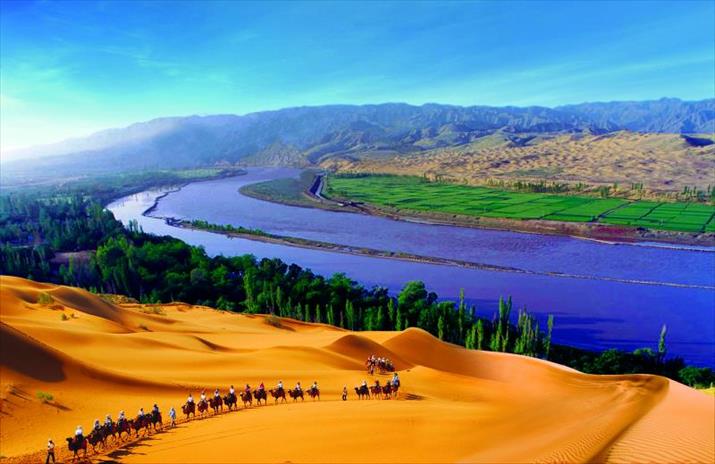| Ningxia |
| Ningxia Seeking The Fruits of Tourism | |
| Mysterious culture, unique ethnic Hui customs and vast deserts have attracted numerous tourists during the past three decades | |
|
|
 The Shapotou Tourism Area, situated in Zhongwei City of Ningxia Hui Autonomous Region, is regarded as one of the most beautiful deserts in China (COURTESY OF THE CPC NINGXIA HUI AUTONOMOUS REGIONAL COMMITTEE)
"The lush field north of the Great Wall has become more and more beautiful, breeding some new hopes," said Chinese President Xi Jinping during his inspection tour to Ningxia Hui Autonomous Region in July 2016. That year, a song named Let's Go to Ningxia became widely known in China, whose lyrics and melody became the region's calling card.
Ningxia has attracted numerous tourists during the past three decades through the appeal of its mysterious culture, unique ethnic Hui customs and vast deserts. Late start but fast growth Started in 1986, Ningxia's tourism industry has made achievements in the past three decades. Particularly during the 12th Five-Year Plan (2011-15) period, the region's tourism industry realized fast, sound and sustainable development, with industrial volume growing rapidly, market players diversifying and brand building showing results. Ningxia has regarded tourism as an important growth industry for the region ever since the 12th Five-Year Plan period, and has issued a guideline which aims to improve and develop the sector. The region has successfully held events such as the Seventh Roundtable Conference for Cross-Straits Tourism Exchanges and two China-Arab states tour operators conferences. These events sought to demonstrate Ningxia's image of ethnic unity, social progress, economic prosperity and tourism development. Tourism has become a strategic pillar industry for the region's economy. Ningxia has made remarkable progress in creating a distinct and diversified tourism industry by establishing its deserts, the Yellow River and ethnic Hui customs as important tourist attractions. Since the start of the 13th Five-Year Plan (2016-20) period, Ningxia has maintained the rapid and sound development of its tourism industry, and has entered the ranks of the country's top five provinces and autonomous regions in terms of tourism growth. The region received 21.5 million tourist visits in 2016, surpassing 20 million for the first time and registering year-on-year growth of 17.1 percent. A total of 207,000 travelers entered or exited China via Ningxia, surpassing 200,000 for the first time and growing by 97 percent year on year. Moreover, revenue generated from the tourism industry totaled 21 billion yuan ($3.07 billion), surging by 30.2 percent over the previous year. Tourism revenue accounted for 6.73 percent of the region's GDP in 2016. It has played a significant role in ensuring the region's stable economic growth, readjusting its economic structure, expanding domestic demand and improving people's well-being. Zhou Ping, Deputy Director of Hainan Tourism Development Commission, has told media that Ningxia Hui Autonomous Region and Hainan Province—both small in size—have the potential to develop their appeal to tourists. He said Ningxia's abundant geographic and cultural resources could help the region develop the industry. Ningxia's 2016 government work report aims to make the entire province a tourist attraction. At a conference held on March 11, 2016, Ningxia's authorities published a scheme formulating the targets and key tasks needed to establish the region as a comprehensive demonstration area for tourism. Ningxia has adopted a slew of new measures to develop its tourism. It had hosted a regional conference for the promotion of tourism and was appointed as the country's second demonstrative province/autonomous region for tourism after Hainan. Ningxia held a Sino-U.S. high-level dialogue for tourism, which became the highlight of the China-U.S. Tourism Year. Moreover, the "Driving along the Silk Road Friendly Tour from China to the Arab States" event was held to promote Ningxia's role along the Silk Road Economic Belt and in the tourism exchange between China and Arab states. A number of other events were also held, such as the campaigns for top 10 local delicacies, top 10 tourist guides and top 100 tourist services, which improved the quality of tourist services in the region and created a better environment for the industry's development. Upon the Central Government's approval, the autonomous region's tourism administration was transformed into the tourism development committee in 2016. Then, the cities of Guyuan and Zhongwei in Ningxia established their tourism development committees. Therefore, party committees and governments at various levels—rather than the local tourism authorities—become responsible for the development of the tourism industry. This has greatly enhanced public awareness and enthusiasm and improved local governments' efforts to develop the sector.  The Western Xia Imperial Tombs, located at the foot of the Helan Mountains in Ningxia Hui Autonomous Region, a must-go spot for tourists interested in the history of the Western Xia Kingdom (1038-1227) (COURTESY OF THE CPC NINGXIA HUI AUTONOMOUS REGIONAL COMMITTEE)
Abundant tourist spots
Li Jianhua, Secretary of the Committee of the Communist Party of China (CPC) of Ningxia Hui Autonomous Region, said that with rapid development, tourism should gradually become the backbone industry for the region. The autonomous region's government must further improve its infrastructure and enhance its publicity in order to establish the region as a distinct international tourist destination. Xian Hui, Chairwoman of Ningxia Hui Autonomous Region, said that Ningxia has embraced a new starting point, and to develop its tourism comprehensively, the government must regard the entire region as one tourist spot and build a new brand that covers the entire region. At the beginning of 2017, Ningxia proposed to draw up a development plan for tourism in the region as soon as possible. The region will also carry out the requirements of the national tourism work conference, establish a new vision on tourism featuring innovation, coordination, green development, opening up and shared development, and accelerate the development of the industry. 2017 will be a crucial year for Ningxia as it seeks to establish itself as a tourism demonstration region. Ningxia will highlight the role of innovation, emphasize coordinated development, consolidate new advantages regarding tourism development, and give prominence to opening up and cooperation. The region will also expand new spaces for the development of its tourism industry. Furthermore, the region will promote inter-departmental cooperation, resource reorganization and industrial integration, accelerate supply-side structural reform of the tourism industry, and keep enhancing the role of tourism in boosting consumption and investment, reducing poverty and raising people's incomes. Through these measures, the region will be capable of realizing the goal of ensuring stable economic growth, boosting reforms, readjusting its economic structure and improving people's well-being. The goal for 2017 is to receive 23.8 million tourist visits and generate 24 billion yuan ($3.5 billion) worth of revenue from tourism, up by 10 percent and 15 percent, respectively, year on year. The tourism industry's role as a strategic pillar industry for the region's economy will be further consolidated this year. To realize this goal, Ningxia will establish more exclusive scenic spots, build more leisure tourism projects and products, and develop more tourism projects featuring Long March landmarks. The region will also enhance the role of tourism in targeted poverty alleviation, build more public facilities for tourism, develop new projects for ice and snow tourism, and provide new distinctive souvenirs. In his inspection tour to Ningxia in 2016, President Xi said: "It is right to comprehensively develop tourism here in Ningxia, and it must be continued." In the future, the region will, taking its own conditions into consideration and guided by a new developmental vision, work harder to vigorously implement the region's three-year action plan for the comprehensive development of tourism and try to bring the industry to a new stage. Copyedited by Bryan Michael Galvan |
|
||||||||||||||||||||||||||||
|
